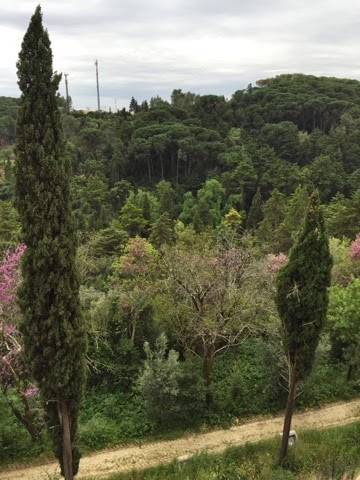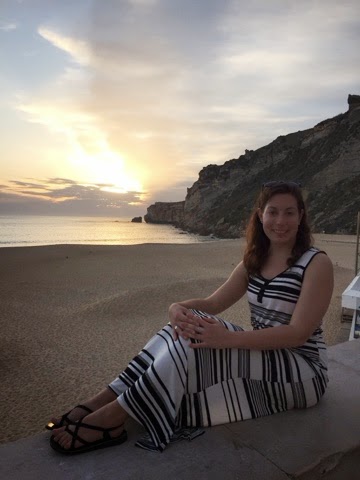There were probably four different places we were excited about seeing - we missed Quinta de Regaleira and another palace, so guess we'll have to come back to Portugal again someday...
We bought some Starbucks on the way to the ticket machines after taking advantage of the cold but fine continental breakfast at the hotel, then buying tickets was made more complicated by the fact that some machines took cash, some took card, and some just didn't work. We made it on the next train, and watched the city roll back and the burbs roll by. It wasn't until the last stop or two before Sintra that even the populated buildings rolled back into forests.
We were torn - we wanted to picnic at the Pena Palace (recommended by Rick), but we also didn't bring anything but the bottle of wine from last night to picnic with. We stopped at a cafe as we kept a lookout for the bus up the massive hill to the palace. We found quiche and some pastries, and packed it up as best as possible for the next hour as we trundled up the hill.
I was awestruck once we got closer to the hill where the palace and ruins of a Moorish castle both live. The palace looked like Disneyland - pastel pink exteriors with cake-decorated roofs, icing along the sides, and towers that were evocative of the Cinderella Castle.
We got to the entrance and lined up at the ticket booth. I was a bit worried - our Portugal book was a bit out-of-date and it appeared like we had to buy a ticket to bring in a picnic... Or just say that we were just bringing in snacks and hope my bag didn't get searched.
All that rule breaking got us hungry, especially when we learned the shuttle up to the castle (yes, despite a 20-minute bus trip up a mountain, the castle was still further uphill within its property) wasn't leaving for another twenty minutes.
I was concerned about the employees that were around the entrance, so we did some hiking to find a secluded spot, sat on a fallen tree, and ate our quiche. We were not caught. It was probably overly cautious, but I hate breaking rules. Besides, we got to see some of the gardens!
We took the minibus up, which gave us glimpses of the gorgeous day it was turning into, as well as the shocking castle.
We disembarked, then headed up and around into a whitwashed, tunneled entryway. With the next burst of sunshine, we were in the land of Oz and Willy Wonka and Walt all at once. The perfectly manicured flower beds were right next to a keyhole door, which was very Islamic; the Moorish influences were present in the doorways and the onion domes on some of the towers.
It was with a sense of wonder that we poked around the palace. It was large, so we first circled the outside to see the astonishing views of the ocean, the surrounding countryside, and the Moorish castle ruin on another, lower, peak of the hill we were on.
The chapel was at the end of the circle. Inside was a stained glass window and a small altar. It was the most similar to the "outside world." No ridiculously crazy colors - just some art. King Manuel had it commissioned when he saw Vasco de Gama returning from his voyage, so that is pretty cool.
We headed inside to the living quarters built for King Ferdinand. After he died in 1885, it transitioned to his next heir, but the uprising in 1910 meant that the royalty fled and the palace stayed as it was until basically we visited.
There was a phone (that Ferdinand apparently heard the Lisbon opera from when he couldn't be bothered to go back for a performance) and some other oddly modern luxuries. but I was pretty much just in love with the courtyard and its peace within chaos. The rooms weren't all that crazy, except for the patterned wallpaper.
The property of the castle was recommended as well, so I sketched out a hike we could do to see "the queen's throne", a temple-looking thing, and some overlooks. The path started by going drastically down the mountain, then straight back up - not ideal, but it eventually got us to the pagoda, where we pulled out the wine and had the second half of our "picnic."
It was a gorgeous view across the trees to the palace from the "queen's throne" - a seat cut into some rocks. Given the difficulty we had in climbing the boulder staircase, I'm impressed that a regally dressed queen could make it up there.
We headed back down hill (yay) toward the lower gate, where we could hop on the bus again to get to the Moorish Castle before dark (or it closed, whichever came first). We took our time strolling through the gardens, voguing in front of flowers and shrubs, then finding the duck ponds filled with, you guessed it, swans. (You probably didn't guess it. There were ducks in the third pond, but the first two were white then black swans.)
Going to the lower gate meant that we got to walk through the grounds more, and it meant we could get on the bus before the mass of people that were trying to leave the palace swarmed it. We were only going to the next stop, but that was still enough away that the bus was the way to go.
Which brings us to The Moorish Castle - one of highlights of the trip for me. It was perfect weather, with a little breeze keeping us cool. It was situated in a ferny, shadowy forest, and you follow an ancient stone wall which then opens up to a gate (with a ticket booth). The path steeply rises, and you are within a new time then when you started.
Sure is the mysticism of ruins for me. Human-made, yet nature-enhanced, they are so foreign as to be beautiful. Alisa and I started climbing to reach the path around the complex.
We had some great interactions with other tourists. We played photographer for an English girl who was tired of taking selfies. I talked briefly to a German guy who wanted to know if I'd been the full way around, then promptly put his headphones back in and out-paced us to the highest point on the opposite side. With enough pictures as an excuse (get out of breath, must be a picture you can take!), we made it to the tower, the last defense of the castle. And we proceeded to spend 10 minutes creating a jumping picture.
There was a cistern under the courtyard, but other than that, it was just the hike around the walls, and the imposing view, that won me over.
It was around closing time for the castle, and we were dog-tired. The long entryway was less romantic on the way out. The bus ride went through town, which was too tempting not to get off at. We saw the National Palace, then got some queijadas at Casa Piriquita. It was so nice to sit down and get served that we proceeded to order another round of pastries (a nutty tart) and some espressos... for not me.
We shopped our way back to the bus stop. Alisa popped into the shop right next to it to get yet another espresso, and we kept watch as we were looking for the minibus to round the corner. She got her drink before it came, no worries.
We went straight from the bus into the train, which pulled off five minutes later. Good thing we bought round-trip tickets in the morning!
We got back to the hotel, did some searching, and I found a tapas bar on the border of the Baixa and the Alfama that was hadn't explored yet. I was sure that one of us was going to protest at the mile walk, but we all trouped along to find the restaurant.
Newsflash - Googling restaurants in English in Portugal is never going to find you up-to-date results. It had closed a few months back, a waiter told us at a nearby establishment. Sad, but at least I wasn't kick-a-pole angry. We looked at the menu for the restaurant that helped us out, but didn't see anything vegetarian. I'm not sure what sparked this, but I pulled open the door yet again to ask about vegetarian options... It appears the restaurants don't put their full menu in the displays on the street! If I had only known this sooner, we might have saved some frustration. Guess that's another reason we'll have to go back!
Alex ended up with an eggplant or squash or something that looked delicious. Alisa and I split a seafood pot and a cut of pork that was spectacular. The restaurant itself was borderline touristy (it had shelves of goods you could buy and take with you and all the waiters spoke good English), but still felt like it had real Portuguese character. The bartender, who didn't speak English, treated us to a shot that I can't remember what it was supposed to be (perhaps it was grappa again?) and told us - once he heard we were stuffed to the brim - that he'd put us in a wheelbarrow and get us back to our hotel.
We enjoyed that meal. It was our last true one in Portugal, and it was a great setting to reminisce on the half dozen cities and many different settings we had managed in just over a week.
The next morning was for packing, eating breakfast, calling a cab, checking in to our flight, then settling down for the same selection of movies. We had yet another awkward layover in Newark, though we got Qdoba since we were out of security coming through internationally. Grandma and Grandpa picked us all up, I got to see my Ellie dog, and Alisa and Alex were on the road to their respective cities. One more country down, and back to work on Monday.













































